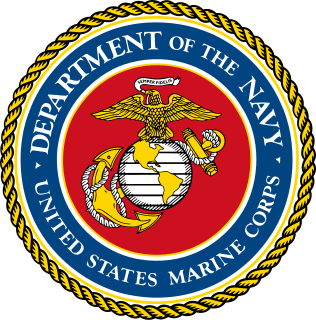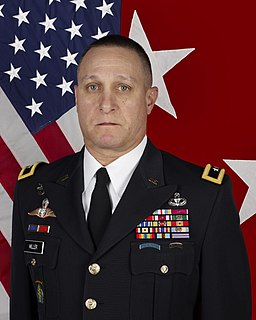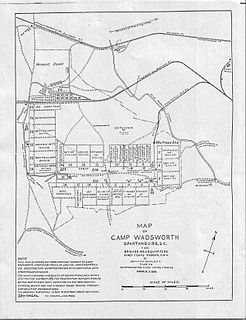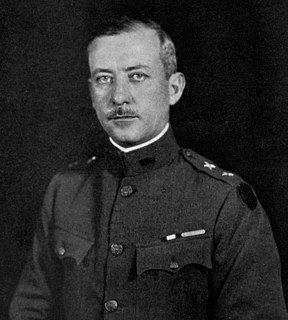
The Polish II Corps, 1943–1947, was a major tactical and operational unit of the Polish Armed Forces in the West during World War II. It was commanded by Lieutenant General Władysław Anders and fought with distinction in the Italian Campaign, in particular at the Battle of Monte Cassino. By the end of 1945, the corps had grown to well over 100,000 soldiers.

The 76th Infantry Division was a unit of the United States Army in World War I, World War II and the Cold War. The division was inactivated in 1996 and has been reconstituted as the 76th US Army Reserve Operational Response Command in 2013.

The 44th Infantry Division was a division of the United States Army National Guard from October 1920 to November 1945, when it was inactivated after Federal Service during World War II. A second 44th Infantry Division existed in the Illinois Army National Guard from 1946 until October 1954, when that division was disbanded after federal service during the Korean War.

The 42nd Infantry Division (42ID) ("Rainbow") is a division of the United States Army National Guard. The 42nd Infantry Division has served in World War I, World War II and the Global War on Terrorism (GWOT). The division is currently headquartered at the Glenmore Road Armory in Troy, New York.

The 37th Infantry Division was a unit of the United States Army in World War I and World War II. It was a National Guard division from Ohio, nicknamed the "Buckeye Division". Today, its lineage is continued through the 37th Infantry Brigade Combat Team, with battalions from Ohio, Michigan, and South Carolina.

The 27th Infantry Division was a unit of the Army National Guard in World War I and World War II. The division traces its history from the New York Division, formed originally in 1908. The 6th Division designation was changed to the 27th Division in July 1917.

The New York Guard (NYG) is the state defense force of New York State, also called The New York State Military Reserve. As of June 2008, the New York Guard, a recognized command under the New York State's Military law, has line-item funding in the state budget.
The Pakistan Military Academy at Kakul (PMA), also known as PMA Kakul, is a military academy in Kakul, Abbottabad that offers two-year accredited federal service military education. The Pakistan Military Academy is similar in function to Sandhurst, Saint-Cyr, and West Point, and provides training to the officers of Pakistan Army and Allied countries. The academy has four training battalions, and 16 companies. Approximately 2,000 invited guests from over 34 countries tour the facility each year. Many close allies of Pakistan send their own cadets and officers to receive premier training in modern military doctrine at PMA.On July 22, 2015 the COAS inaugurated the incoming 4th battalion for training.

The United States Marine Corps is organized within the Department of the Navy, which is led by the Secretary of the Navy (SECNAV). The most senior Marine commissioned officer is the Commandant of the Marine Corps, responsible for organizing, recruiting, training, and equipping the Marine Corps so that it is ready for operation under the command of the unified combatant commanders. The Marine Corps is organized into four principal subdivisions: Headquarters Marine Corps, the Operating Forces, the Supporting Establishment, and the Marine Forces Reserve.
Camp Smith is a military installation of the New York Army National Guard in Cortlandt Manor near Peekskill, NY, about 30 miles (48 km) north of New York City, at the northern border of Westchester County, and consists of 1,900 acres (7.7 km2). Established in 1882 by General Frederick Townsend, Adjutant General of New York, it was formerly known as "Camp Townsend", but was renamed in 1919 to "Camp Smith" for Governor Alfred E. Smith of New York.

Daniel Davidson Bidwell was a civic leader in Buffalo, New York, before the outbreak of the American Civil War. He enlisted early in the war and then was appointed colonel of a regiment of infantry. He was promoted to general in command of a brigade in early 1864, leading it until he was mortally wounded at the Battle of Cedar Creek.

Kenneth F. Cramer was a United States Army major general who served as Chief of the National Guard Bureau.

The Adjutant General of New York is the highest-ranking military official in the New York National Guard as the state adjutant general. The adjutant general is part of the state government's executive branch, and serves as head of the New York State Division of Military and Naval Affairs, which includes the New York Army National Guard, New York Air National Guard, the New York Guard, and the New York Naval Militia.
The 1889 Birthday Honours were appointments by Queen Victoria to various orders and honours to reward and highlight good works by citizens of the British Empire. The appointments were made to celebrate the official birthday of The Queen, and were published in the London Gazette on 24 May 1889 and in The Times on 25 May 1889.
The 1891 Birthday Honours were appointments by Queen Victoria to various orders and honours to reward and highlight good works by citizens of the British Empire. The appointments were made to celebrate the official birthday of The Queen, and were published in the London Gazette on 29 May 1891 and in The Times on 30 May 1891.
The 1881 Birthday Honours were appointments by Queen Victoria to various orders and honours to reward and highlight good works by citizens of the British Empire. The appointments were made to celebrate the official birthday of the Queen, and were published in The London Gazette on 24 May 1881.

Harry E. Miller Jr. is retired Army National Guard officer. A veteran of the Iraq War, he attained the rank of major general as commander of the 42nd Infantry Division, a position he held from 2013 to 2017.

Camp Wadsworth was a World War I-era training facility for the United States Army. Located near Spartanburg, South Carolina, the post was in operation from its opening in July 1917 until it was inactivated in March 1919, following the Armistice that ended the war.


























